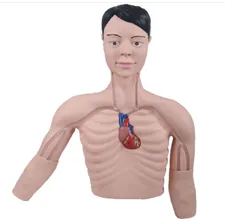Peripheral catheterization central venous catheter (PICC) is a common and important technique in medical interventional therapy, widely used in long-term drug infusion and hemodialysis. However, there is a certain risk of complications during PICC catheterization, such as pneumothorax, thrombosis, and improper catheter placement. Therefore, medical students must have sufficient technical proficiency and the ability to deal with emergencies when learning PICC catheterization. The PICC interventional training model, as a highly simulated teaching tool, helps students manage these clinical complications in a safe and controlled environment.
Simulated clinical complication

PICC Interventional Training Model
PICC interventional training models are usually designed to simulate multiple clinical complications. For example, by simulating the failure of a blood vessel puncture, the occurrence of a deep or shallow catheter, and the occurrence of a pneumothorax, the training model can help students understand the causes of these problems and how to deal with them. In the simulation process, students can train through repeated operations and gradually master how to make correct judgment and treatment when complications occur.
One study showed that simulation training using a PICC interventional training model enabled participants to better identify complications, especially in the case of pneumothorax and catheter misplacement, and improved the participants' emergency response speed by approximately 25%. This shows that the training of simulating complications can effectively improve the clinical coping ability of the trainees.
Clinical significance and emergency response
In clinical practice, PICC catheterization complications often occur at critical moments during operation, which may affect patient safety. By simulating different complication scenarios, PICC interventional training model helps students to familiarize themselves with and master coping strategies in a risk-free environment, such as timely detection of pneumothorax signs and exhaust treatment, or correct assessment of catheter position and correction. This kind of training not only improves the technical level of the students, but also enhances their ability to react quickly in actual operation.
Data support and learning effect
The effectiveness of the PICC intervention training model can be reflected through the data feedback. The modern training model is equipped with an intelligent monitoring system that records the trainees' operational data in real time, such as the accuracy of puncture, the depth of puncture, and the operation time. Through these data, students can clearly understand their shortcomings in operation and make targeted improvements. The data showed that the clinical error rate of the trainees trained with this model was reduced by more than 30% compared with the trainees who did not receive the training.
conclusion
By simulating various clinical complications, the PICC interventional training model can help medical students master PICC catheterization skills in a risk-free environment and effectively deal with possible emergencies. Through repeated practice and data feedback, participants are able to improve their operational skills and emergency response capabilities, thereby improving patient safety and treatment outcomes in clinical practice. Therefore, PICC interventional training model is an indispensable tool in medical education.
